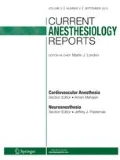Abstract
Poorly treated acute pain after cesarean delivery is associated with significant short-term and long-term morbidity in young women. Due to the importance of treating perioperative pain, more emphasis has been placed on improving postoperative pain management. However, individual differences in pain perception make postoperative pain management challenging after cesarean delivery. In this review, we will identify recent studies that have utilized a variety of preoperative tests to predict acute and/or chronic postoperative pain scores after cesarean delivery.
Similar content being viewed by others
References
Papers of particular interest, published recently, have been highlighted as: • Of importance •• Of major importance
Eisenach JC, Pan PH, Smiley R, et al. Severity of acute pain after childbirth, but not type of delivery, predict persistent pain and postpartum depression. Pain. 2008;140:87–94.
•• Abrishami A, Chan J, Chung F. Preoperative pain sensitivity and its correlation with postoperative pain and analgesic consumption. Anesthesiology. 2011;114:445–57. A systematic review of 15 studies addressing the effect of preoperative pain assessment in different surgical patients on postoperative pain scores.
Werner MU, Mjobo H, Nielsen PR, Rudin A. Prediction of postoperative pain: a systematic review of predictive experimental pain studies. Anesthesiology. 2010;112:1494–502.
Hsu Y, Somma J, Hung Y, et al. Predicting postoperative pain by preoperative pain assessment. Anesthesiology. 2005;103:613–8.
Granot M. Can we predict persistent postoperative pain by testing preoperative experimental pain? Curr Opin Anaesthesiol. 2009;22:425–30.
Granot M, Lowenstein L, Yarnitsky D, et al. Post-cesarean section pain prediction by preoperative experimental pain assessment. Anesthesiology. 2003;98:1422–6.
Pan PH, Coghill R, Houle TT, et al. Multifactorial preoperative predictors for postcesarean section pain and analgesic requirements. Anesthesiology. 2006;104:417–25.
Strulov L, Zimmer EZ, Granot M, et al. Pain catastrophizing, response to experimental heat stimuli, and post-cesarean section pain. J Pain. 2007;8:273–9.
Granot M, Ferber SG. The roles of pain catastrophizing and anxiety in the prediction of postoperative pain intensity: a prospective study. Clin J Pain. 2005;21:439–45.
Buhagiar LM, Cassar OA, Brincat MP, et al. Predictors of post-cesarean section pain and analgesic consumption. J Anaesthesiol Clin Pharmacol. 2011;27(2):185–91.
Nielsen PR, Norgaard L, Rasmussen LS, et al. Prediction of postoperative pain by an electrical pain stimulus. Acta Anaesth Scand. 2007;51:582–6.
Buhagiar LM, Cassar OA, Brincat MP, et al. Preoperative pain sensitivity: a prediction of post-operative outcome in the obstetric population. J Anaesthesiol Clin Pharmacol. 2013;29:465–71.
Woolf CJ. Central sensitization: implications for the diagnosis and treatment of pain. Pain. 2011;152:S2–15.
Wilder-Smith OH, Arendt-Nielsen L. Postoperative hyperalgesia: its clinical importance and relevance. Anesthesiology. 2006;104:601–7.
• Ortner CM, Granot M, Richebe P, et al. Preoperative scar hyperalgesia is associated with post-operative pain in women undergoing a repeat cesarean delivery. Eur J Pain. 2013;17:111–23. Preoperative cesarean scar hyperalgesia is associated with central sensitization and increased postoperative pain scores after repeat cesarean delivery.
Weissman-Fogel I, Granovsky Y, Crispel Y, et al. Enhanced presurgical pain temporal summation response predicts post-thoracotomy pain intensity during the acute postoperative phase. J Pain. 2009;10:628–36.
•• Pan PH, Tonidandel AM, Aschenbrenner CA, et al. Predicting acute pain after cesarean delivery using three simple questions. Anesthesiology. 2013;118:1170–9. A simple three question survey can predict patients in the top 20th percentile for severe acute pain following cesarean delivery.
Nikolajsen L, Sorensen HC, Jensen TS, Kehlet H. Chronic pain following cesarean section. Acta Anaesthesiol Scand. 2004;48:111–6.
Rafique Z, Schibli KU, Russell IF, Lindow SW. A randomized controlled trial of the closure or non-closure of peritoneum at cesarean section: effect on post-operative pain. Br J Obstet Gynecol. 2002;109:694–8.
Loos MJ, Scheltinga MR, Mulders LG, et al. The Pfannenstiel incision as a source of chronic pain. Obstet Gynecol. 2008;111:839–46.
Yarnitsky D, Crispel Y, Eisenberg E, et al. Prediction of chronic post-operative pain: pre-operative DNIC testing identifies patients at risk. Pain. 2008;138(1):22–8.
Li S, Sng BL, Allen J, et al. Evoked mechanical temporal summation, but not inefficient diffuse noxious inhibitory control, is a predictor of persistent post-cesarean section pain. Eur J Anaesthesiol. 2013;30:170.
Landau R, Kraft JC. Pharmacogenetics in obstetric anesthesia. Curr Opin Anesthesiol. 2010;23:323–9.
Jubieta JK, Heitzeg MM, Smith YR, et al. COMT val158met genotype affects mu-opioid neurotransmitter responses to a pain stressor. Science. 2003;299:1240–3.
Tan EC, Lim EC, Teo YY, et al. Ethnicity and OPRM variant independently predict pain perception and patient-controlled analgesia usage for postoperative pain. Mol Pain. 2009;5:32.
Jensen KB, Lonsdorf TB, Schalling M, et al. Increased sensitivity to thermal pain following a single opiate dose is influenced by the COMT val(158)met polymorphism. PLoS One. 2009;4:e6016.
• Landau R, Bollag L, Ortner C. Chronic pain after childbirth. Int J Obstet Anesth. 2013;22:133–45. Multiple factors influence the development of chronic pain after delivery, and management of acute pain after cesarean delivery is necessary to prevent the development of persistent pain.
Landau R, Kraft JC, Flint LY, et al. An experimental paradigm for the prediction of post-operative pain (PPOP). J Vis Exp. 2010;35:e1671.
Author information
Authors and Affiliations
Corresponding author
Additional information
This article is part of the Topical Collection on Obstetric Anesthesia.
Rights and permissions
About this article
Cite this article
Booth, J., Pan, P. Predicting Postcesarean Delivery Pain. Curr Anesthesiol Rep 5, 100–105 (2015). https://doi.org/10.1007/s40140-014-0087-0
Published:
Issue Date:
DOI: https://doi.org/10.1007/s40140-014-0087-0




